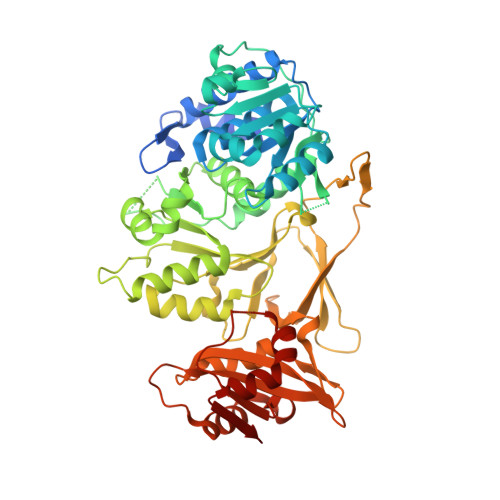Discovery, characterization and engineering of ligases for amide synthesis.
Winn, M., Rowlinson, M., Wang, F., Bering, L., Francis, D., Levy, C., Micklefield, J.(2021) Nature 593: 391-398
- PubMed: 34012085
- DOI: https://doi.org/10.1038/s41586-021-03447-w
- Primary Citation of Related Structures:
7A9I, 7A9J - PubMed Abstract:
Coronatine and related bacterial phytotoxins are mimics of the hormone jasmonyl-L-isoleucine (JA-Ile), which mediates physiologically important plant signalling pathways 1-4 . Coronatine-like phytotoxins disrupt these essential pathways and have potential in the development of safer, more selective herbicides. Although the biosynthesis of coronatine has been investigated previously, the nature of the enzyme that catalyses the crucial coupling of coronafacic acid to amino acids remains unknown 1,2 . Here we characterize a family of enzymes, coronafacic acid ligases (CfaLs), and resolve their structures. We found that CfaL can also produce JA-Ile, despite low similarity with the Jar1 enzyme that is responsible for ligation of JA and L-Ile in plants 5 . This suggests that Jar1 and CfaL evolved independently to catalyse similar reactions-Jar1 producing a compound essential for plant development 4,5 , and the bacterial ligases producing analogues toxic to plants. We further demonstrate how CfaL enzymes can be used to synthesize a diverse array of amides, obviating the need for protecting groups. Highly selective kinetic resolutions of racemic donor or acceptor substrates were achieved, affording homochiral products. We also used structure-guided mutagenesis to engineer improved CfaL variants. Together, these results show that CfaLs can deliver a wide range of amides for agrochemical, pharmaceutical and other applications.
- Department of Chemistry, Manchester Institute of Biotechnology, The University of Manchester, Manchester, UK.
Organizational Affiliation:


















